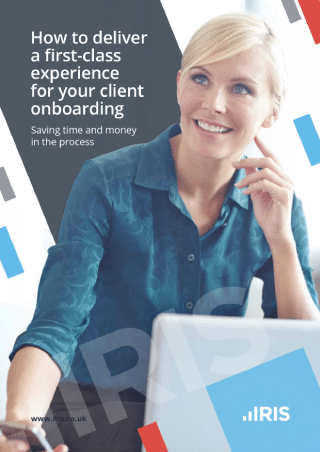What is client onboarding?
Client onboarding is the process your business follows when starting to work with a new client.
Many businesses – especially those providing managed services – have a client onboarding process. It might include gathering client data, defining project parameters and establishing a point of contact.
If you’re providing accounting or bookkeeping services, a robust client onboarding process is an absolute must.

Why is client onboarding important for accountants?
Accountants and bookkeepers carry out high-stakes work for their clients, providing a service that’s heavily regulated. There’s no room for error.
A fast, efficient client onboarding system means:
- Vital client checks are completed promptly and thoroughly
- Your team knows exactly what to do, saving time and resources
- Your clients are suitably impressed, avoiding the sting of buyer’s remorse.

Featured Guide
How to Improve the Client Onboarding Process: A Guide for Accountants and Bookkeepers
Why are so many accountants and bookkeepers getting client onboarding wrong? And what can you do to get it right?
Read our guide to find out, and discover:
- Client onboarding 101
- Your onboarding obligations
- Common onboarding mistakes
- The ultimate client onboarding wish-list
- Onboarding software solutions.
What checks are required as part of client onboarding?
When accountants and bookkeepers welcome a new client, the onboarding process involves industry-standardised Customer Due Diligence (CDD) checks, including:
- Personal and business background, e.g. legal structure
- Breakdown of share/partnership structure
- Key business partners and suppliers
- Income sources and trading history
- Essential anti-money laundering (AML) compliance e.g. transaction monitoring.
Having a robust client onboarding process ensures CDD is carried out quickly, efficiently and with less potential for error.

Client onboarding mistakes accountants need to avoid
A good onboarding process should take the stress and strain out of bringing on a new client.
If any of these scenarios sound familiar, your current system might be letting you down:
-
Bringing in the wrong type of client
Unfortunately, not all clients are a good fit for your business. A thorough onboarding process filters out clients who:
- Expect a level of support you haven’t capacity for
- Don’t mesh well with your company values
- Want a specific type of service you don’t provide
- Aren’t compliant with CDD or AML checks.
Sometimes, it pays to be picky at the start!
-
Poor proposal process
New clients mean drafting new proposals – a time-consuming task to complete, especially if you’re doing it from scratch.
Equally, if you’re relying on a generic template, you risk submitting a proposal that doesn’t reflect the client’s specific needs.
Ideally, you want an onboarding system that includes a range of proposal templates, plus the ability to make adjustments so your client receives something bespoke.
-
Not setting expectations for the client
Like any relationship, communication is key. A decent onboarding system can help reduce instances of missed connections and crossed-wires, ensuring clients know:
- How long things like onboarding or CDD take
- What information you need from them
- Who their point of contact in the business
- What vital logistics – like payment – looks like
By letting the client know what to expect (and what’s expected of them), you avoid souring an otherwise promising business relationship.
-
Inconsistent onboarding workflow
Having a standardised client onboarding process – with scope to adjust for each client – means you avoid situations like:
- Staff not knowing who’s doing what when a new client comes aboard
- Tasks get missed (or completed twice by different employees), affecting progress
- Chaos ensues when the colleague who “always handles onboarding” is on leave
- Outdated or non-compliant documentation is accidentally shared with the client
- Onboarding templates/guidance aren’t kept in an accessible space where everyone can access them.
-
Not having digital processes in place
Using technology to improve your client onboarding process isn’t just helpful for business, it’s what clients have come to expect.
- Require clients to visit the office for ID verification? They may opt for a competitor that does it all online.
- Forget to update the client during a lengthy CDD check? They might come down with a bad case of buyer’s remorse.
- Still relying on a paper-based system (and assuming clients do the same)? Tech-invested customers might think twice about coming aboard.
-
Leaving room for scope creep
Scope creep occurs when, after the project begins, it starts to grow outside of the original parameters you originally agreed upon.
Having a rock-solid onboarding process ensures everyone understands and agrees with what services you’re providing – and where your limits are. It means avoiding issues like:
- Clients pushing for additional services (at no extra cost to them)
- Projects deadlines running over, impacting other work/clients
- Clients left unsatisfied with progress because of unrealistic expectations.
Bringing in the wrong type of client
Unfortunately, not all clients are a good fit for your business. A thorough onboarding process filters out clients who:
- Expect a level of support you haven’t capacity for
- Don’t mesh well with your company values
- Want a specific type of service you don’t provide
- Aren’t compliant with CDD or AML checks.
Sometimes, it pays to be picky at the start!
Frequently asked questions
Client onboarding can mean different things to different businesses. Check out these FAQs and learn more about client onboarding for accountants and bookkeepers.
-
Technically, no, but most businesses have a client onboarding process of some sort (whether they realise it or not).
However, when your business needs to jump through dozens of legal hoops – like mandated “due diligence” and AML checks, for example – to even begin working with a new client, a solid onboarding process is invaluable.
While other businesses may be able to go with the flow when bringing on new clients, accountants and bookkeepers cannot afford to.
-
Managed services client onboarding refers to how certain types of service-providers welcome and set-up new clients.
Managed (or professional) services like accountants or bookkeepers need to think carefully about their client onboarding process.
After all, if you want clients to trust you with their core processes, a sloppy onboarding experience will sink the ship before it’s even out of the harbour.
-
There are lots of reasons Professional Services (sometimes referred to as B2Bs) ( like accountants and bookkeepers ) should prioritise client onboarding; a big one being they provide professional services with no tangible ‘product’.
When tempting new clients on board, architects can show off a recent build. Office suppliers can send out samples. Fleet providers can offer a test-drive.
For professional services like accountancy, the onboarding process is an opportunity to impress and give clients a first taste of your service.
-
No, you don’t technically need specially-designed onboarding software, like IRIS Elements, to support your client onboarding efforts.
However, there’s no arguing that clients are beginning to expect intuitive and time-saving technology from service-providers.
77% of B2B clients say that technology has dramatically transformed their expectations of how businesses should interact with them – that includes their accountants.
Learn more about client onboarding for accountants

Blog Article
Accountants, automate your way to success with IRIS Elements!

Blog Article
An accountant’s guide to managing software change

Blog Article
